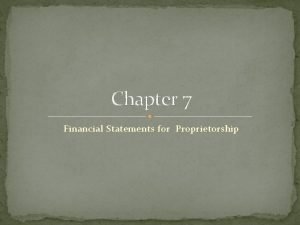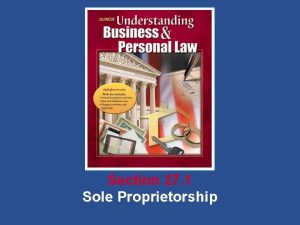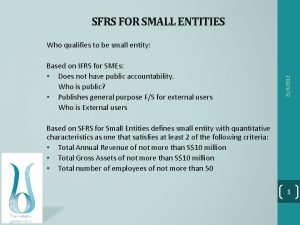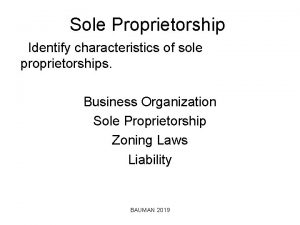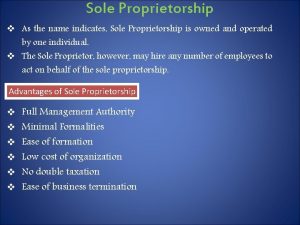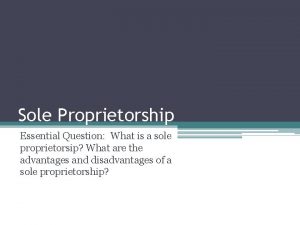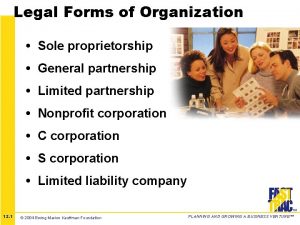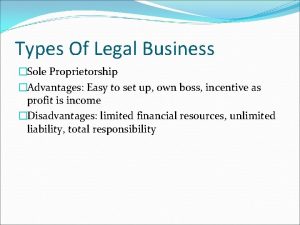Legal Entities Legal Entities 1 Sole Proprietorship 2


























- Slides: 26

Legal Entities

Legal Entities 1. Sole Proprietorship 2. Corporation 3. Limited Liability Company (LLC)

Sole Proprietorship If you don’t from and LLC or incorporate, you are a sole proprietorship. Two or more people (except married couples) must choose another entity.

Sole Proprietorship Disadvantages: more difficult to obtain financing responsible for all business aspects debts are liability are your responsibility Advantages: ease of formation minimal regulation on business operation simple financial record keeping

Sole Proprietorship Legally, you and business are one entity You cannot be an employee of the business No payroll taxes Self-employment taxes Regular income taxes (schedule C)

Schedule C

Partnerships I

Partnerships Eases loneliness of being self-employed Allows time off Adds diversity of services and approaches Decreases overhead expenses

Partnerships When two or more people contribute assets to carry on a jointly-owned business and share in its profits and losses.

Partnerships Similar to sole proprietorship: minimal governmental regulations More involved record-keeping Must obtain a federal ID number (Form SS-4) Must file a schedule K 1 (form 1065) form

Partnerships Partnership itself pays no taxes Each partner files a K-1 form to report profits and losses You are liable for debts and legal obligations incurred by partnership Incorporating or LLC is the best way to protect against liability

Schedule K-1

Corporations

Corporations Major categories: C Corporations S Corporations Professional corporations

Corporations Provides a business entity separate from the owner Creates clear boundaries between work and your life Owners who work in an incorporated business are considered employees Usually the most costly legal structure ! Requires both federal and state (where incorporated) tax filing

Corporations Ü Contact State to determine requirements and fees Ü Many details involved Ü Process varies from state to state Ü You can incorporate under any State (Nevada, etc. . . ) but each state has different regulations - be sure your bylaws include approval of telephone meetings for shareholders and directors

Corporations Minimal requirements: Ü Adopt and file articles of incorporation Ü Develop corporate bylaws Ü Hold first board of directors and shareholders meeting; prepare meeting minutes Ü Issue stock certificates

Corporations Minimal requirements: Ü Obtain IRS employer ID number (EIN Form SS-4) Ü File for subchapter S status (within 75 days) or Start of new business (IRS form 2553) Ü Set up corporate book containing all corporate documents

Corporations Minimal requirements for maintaining corporation status: Ü Conduct annual meetings Ü File minutes in corporate book Ü File documents annually with State

Corporations Ü If corporate book is inadequate, your corporate status can be nullified and result in severe tax consequences. Ü Keep corporate book up to date Ü Consult accountant and attorney

Corporations Reasons for incorporating: Ü Ease of business transfer Ü Ability to raise capital by selling shares of stock Ü Potential tax advantages and fringe benefits - health and life insurance premiums - tuition reimbursement - tax-sheltered retirement plans (fully or partially deducted business expense)

C Corporations Subject to corporate income tax on net profits Potential for double taxation can use all profits as tax-deductible salaries and fringe benefits Income can be divided into paying shareholders and keeping rest of profits in the business (income-splitting) Earnings taxed at 15% (usu. lower than individual taxation) Must file annual return (Form 1120) by 15 th day of 3 rd month after close of fiscal year Must make quarterly tax payments

S Corporations Taxed like partnerships but retain liability protection Same basic structure as C corps Do not pay federal income tax (profits passed onto owners who then pay income tax at individual rates) Primary advantage: reducing double taxation Allows owners to declare business loss on individual returns (usu. first years of business)

Personal Service Corporations (PSCs) Often the choice for wellness professionals Some states require this entity Benefits: owners separate from business fringe benefits similar to C corporations limited liability protection Not usually advantageous for a sole business owner Taxed at a higher rate than other corporations Income-splitting not allowed

Limited Liablity Corporations (LLCs) Hybrid of partnership and a corporation Most states require a minimum of two owners (spouse ok) Offers many benefits of an S corp. with fewer drawbacks Gives owners separate entity from business and provides a limited liability protection shield Profits flow through the owners

Limited Liablity Corporations (LLCs) Paperwork not as complicated Must file Articles of a LLC or develop organizational agreement File for an IRS employee identification number (EIN) May or may not require annual meetings or additional filings with the state Regulations vary: contact the Corporation Commission Secretary of State LLCs file a form 1065 and each member files a yearly K-1 form Each member reports profits/losses on individual tax returns
 Disadvantages of mncs
Disadvantages of mncs Chapter 7 financial statements for a proprietorship
Chapter 7 financial statements for a proprietorship Sole proprietorship and partnership venn diagram
Sole proprietorship and partnership venn diagram Advantages of sole trader
Advantages of sole trader Bookkeeping is a mechanical task which involves
Bookkeeping is a mechanical task which involves Post-closing trial balance for a sole proprietorship
Post-closing trial balance for a sole proprietorship Similarities between sole trader and partnership
Similarities between sole trader and partnership Is microsoft a sole proprietorship
Is microsoft a sole proprietorship Proprietorship example
Proprietorship example Sole proprietorship and partnership venn diagram
Sole proprietorship and partnership venn diagram Financial statement of sole proprietorship
Financial statement of sole proprietorship The advantages of sole proprietorship
The advantages of sole proprietorship X-201 for a sole proprietorship
X-201 for a sole proprietorship Partnership advantages
Partnership advantages I stockphoto
I stockphoto Sole proprietorship
Sole proprietorship Jollibee sole proprietorship
Jollibee sole proprietorship Sole proprietorship
Sole proprietorship Sole trader introduction
Sole trader introduction Sole proprietorship pros and cons
Sole proprietorship pros and cons Chapter 1 starting a proprietorship
Chapter 1 starting a proprietorship Eclipse generate jpa entities from database
Eclipse generate jpa entities from database Partial specialization rule
Partial specialization rule Antecedent pronoun examples
Antecedent pronoun examples Sfrs for small entities
Sfrs for small entities Business entities that operate in a duel market structure
Business entities that operate in a duel market structure Financial statements of non corporate entities
Financial statements of non corporate entities

